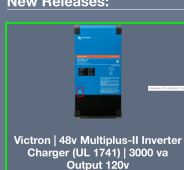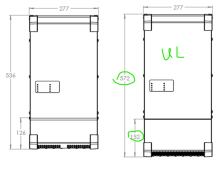solar_trees
New Member
- Joined
- Aug 11, 2022
- Messages
- 40


Interesting development and I absolutely agree we need to await publication of the paperwork, but in the meantime I have a few quick questions:For some reason tags weren't working until just a few days ago..
I'm awaiting the final test report and certificate to mark from Victron, but they are on the price list as UL 1741 certified and bear the mark from the testing lab:
View attachment 136145
View attachment 136147
In my opinion, until they have the authorization to mark paperwork published, there will be some trouble getting a system permitted...but they told me it's coming soon
I trust Victron engineering more than any other hybrid inverter.
UL1741 would have no impact on their present AC coupling capability other than adding the allowance for grid export.
Just want to clarify that this requirement applies to ESS only. My Microinverters are Cal Rule 21 compliant but do not have any remote current sensors on grid mains input lines…From my brief reading of Cal rule 21, the tough part Victron may not address is the power factor correction aspects. Cal rule 21 requires your GT inverter to help improve your house loads power factor. This requires remote current sensors on grid mains input lines to measure total incoming current to voltage phase relationship.
Not sure why you say that. The 120VAC Multiplus II model has an input for a remote CT sensor and comes bundled with one…Victron does have remote CT capability.
Again, interested in how this applies to Microinverters without any CT sensors or other ways to measure mains input I/V phase relationship…To improve load power factor, any power push by GT inverter has to shift the peak current phase profile of the GT inverter, off the normal in-phase with AC voltage on GT inverters, to help correct your house load power factor seen by grid. This power factor correction assist can also reduce your GT inverter maximum output power capability.
Would the same be true for refrigerators and freezers?The primary power factor offender for residential use is air conditioning with their single phase induction motor compressors.
Would such a box require CT sensors on the grid mains and if so, could it be a standalone solution for achieving CA21 compliance or would it need to communicate with the GT inverter?A simpler method would be to put a bank of AC run capacitors, with relays, to kick in various amount of capacitance to compensate power factor. This is how Poco power factor corrects on their transmission lines. Not much to do with GT inverters. My guess is some manufacturer will create a stand-alone add on box to do this to make a non-Cal rule 21 compliant GT inverter effectively compliant.
At least in California, I believe that would require prior approval by the CPUC and probably at least a 1-year advance warning.All new smart meters can measure and report power factor, so it is just a matter of time before Poco's start charging extra for residential poor power factor loads.
1. yes.Interesting development and I absolutely agree we need to await publication of the paperwork, but in the meantime I have a few quick questions:
1/ does this mean that the 48VDC 120VAC Multiplus II has been tested and is being certified in a way that the 24VDC 120VAC Multiplus II and the 24VDC 120x2VAC Multiplus II have not?
2/ Assuming the answer is ‘yes’, do you know whether Victron has any plans to certify the 24V Multiplus II models for UL1741?
3/ Whether it will be UL1741 certified or not, do you know whether Victron has any plans to introduce a 48VDC 120x2VAC Multiplus II into the US market and if so, when?
Thanks for the prompt reply.1. yes.
2. It has not been confirmed or denied...but my sales rep has indicated this is not the direction they are going.
3. Also has not been confirmed or denied, but in my opinion, probably not
I don't work for victron, merely sell it...so don't take my word as fact but rather to the best of my understanding.
Appreciate the detailed reply. Do you have any info on whether UL9540 is being pursued for any systems with Victron inverters?in my opinion, probably not
By the way, one more quick question:1. yes.
2. It has not been confirmed or denied...but my sales rep has indicated this is not the direction they are going.
3. Also has not been confirmed or denied, but in my opinion, probably not
I don't work for victron, merely sell it...so don't take my word as fact but rather to the best of my understanding.
I am going to stop responding in regards to the Victron roadmap because I don't want to speak out of line or have words put into my mouth.By the way, one more quick question:
By ‘not going that direction’ did your sales rep mean that Victron’s strategy for any Multiplus products certified for UL1741 and ESS will be to limit them to 48CDC supply and never introduce UL1741-certified products supplied by 24VDC batteries?
Let's compare more similar products - the UL version of this inverter and the non-ul version.can you summarize the primary differences
Not that I can publicly release.Do you have any info on whether UL9540 is being pursued for any systems with Victron inverters?
Fair enough. I asked Victron directly and will report back on what they say.I am going to stop responding in regards to the Victron roadmap because I don't want to speak out of line or have words put into my mouth.
Just to be certain we are comparing the same models, the new UL-listed Multiplus II PMP482305102 has dimensions of:Let's compare more similar products - the UL version of this inverter and the non-ul version.
The UL version of this inverter has a bigger wiring compartment and different ventilation holes, and the UL markings. I can't distinguish a single other change.
Understood.The differences between a 24v 2x120v and a 48v 1x120v are just as you probably already know - different battery voltage and different output terminals/connections
Not that I can publicly release.
No, those dimensions for the UL model are wrong. It's bigger.And the non-UL-listed Multiplus II PMP482405100 has identical dimensions. So are you stating that the UL-listed model has a larger onternal internal wiring compartment despite the fact that the outside dimensions are identical? Or are you perhaps comparing to the older non-Multiplus II model (the Multiplus PMP482200100)?



